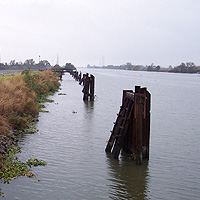
 |
 |
Background
In January 1998, the State Water Resources Control Board (SWRCB) placed the San Joaquin River Deep Water Ship Channel (DWSC), located downstream from the City of Stockton, on the Clean Water Act (CWA) Section 303(d) list. The DWSC regularly experiences periods of low dissolved oxygen (DO) concentrations, which often violate the water quality objectives for DO in the DWSC as specified in the Water Quality Control Plan for the Central Valley-Sacramento River and San Joaquin River Basins (Basin Plan). For the purpose of the TWG, net oxygen demand is defined as the combined impact of all chemical, biological, and physical mechanisms that add or remove dissolved oxygen from the water column. The CWA required that the Central Valley Regional Water Quality Control Board (CVRWQCB) develop a Total Maximum Daily Load (TMDL) to identify causes for the low DO levels and to assign responsibility to correct the problem. Under the Porter-Cologne Water Quality Control Act, the CVRWQCB must also develop a TMDL implementation program to help this part of the DWSC comply with the Basin Planís DO objectives. In addition, the SWRCB Water Right Decision 1641 instructed the CVRWQCB to develop a TMDL before it takes further water rights actions to implement the dissolved oxygen water quality objectives. Any increase in the discharge of oxygen demanding substances or their precursors into waters tributary to the DWSC portion of the San Joaquin River was prohibited after July 12, 2004. Likewise, the discharge of these substances into this portion of the River will be prohibited after December 31, 2011, when net daily flow in this portion of the River is less than 3,000 cubic feet per second, unless dissolved oxygen objectives in the DWSC are being met. These prohibitions do not apply if the discharge is regulated by a waste discharge requirement waiver, by general discharge requirements, by NPDES permits, or if the discharge will have no significant negative impact on the dissolved oxygen impairment in the DWSC. Impairment CausesRecent studies identified three main contributing factors to the low dissolved oxygen levels in the DWSC:
Although there is adequate scientific understanding to support a general allocation of responsibility to the three main contributing factors, there is inadequate understanding at this time to support more detailed wasteload or load allocations to specific point and non-point sources of oxygen demanding substances and their precursors. Actions to Address Impairment Sources and PrecursorsTo address oxygen demanding substance loads and their precursors, those entities responsible for the various sources must complete scientific studies to obtain information for more detailed allocations and eventual implementation of alternate measures. This will be achieved by the CVRWQCB taking the following actions:
Actions to Address Non-Load Related Contributing FactorsDWSC geometry and reduced flows through the DWSC, the two non-point related contributing factors to the low dissolved oxygen levels, are not substance loads for which mass or concentration limits can be assigned. Instead, these factors reduce the capacity of the DWSC to assimilate loads of oxygen demanding substances (load capacity). The following actions are proposed to ensure that alternate measures are implemented to reduce the impact of DWSC geometry on loading capacity to less than the amount apportioned to this factor in the TMDL:
The capacity of the DWSC to assimilate oxygen demand exerted by incoming loads of oxygen demanding substances is a function of the flow rate through the DWSC and of temperature. Based on equitability and other considerations, this TMDL apportions loading capacity (pounds of oxygen demand exerted in the DWSC per day), less a margin of safety in equal amounts to each of the three main contributing factors. To account for flow measurement error and technical uncertainty, a forty-percent margin of safety is imposed on the total loading capacity. Each of the three main contributing factors is also equally responsible for reducing the excess net oxygen demand exerted in the DWSC. Wasteload and Load AllocationsThirty-percent of the loading capacity allocated to the sources of oxygen demanding substances is allocated as a wasteload allocation to the City of Stockton Regional Wastewater Control Facility (RWCF). Sixty percent of the loading capacity apportioned to sources of oxygen demanding substances is allocated as a load allocation to non-point sources of algae and its precursors upstream of the DWSC. Ten percent is allocated as a reserve for unknown sources and impacts, and known or new sources that have insignificant impact, including wasteload allocations for point sources (other than the RWCF) set at their corresponding effluent limitations applicable on July 12, 3004. The following actions are proposed to ensure that measures are implemented to reduce the impact of activities that reduce flow through the DWSC on oxygen demand loading capacity to less than the amount apportioned to these factors in the TMDL:
|
|